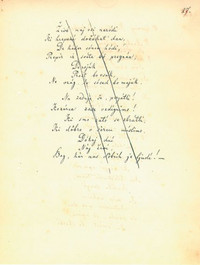National anthem
The text of the Slovenian national anthem is the seventh stanza of Zdravljica (A Toast) by Slovenia's greatest and most celebrated poet, France Prešeren (1800–1849). The melody of the anthem is from the 1905 choral work of the same name by Stanko Premrl. Zdravljica was written in 1844 and published with some changes in 1848, during the Spring of Nations in Europe. It has been interpreted as promoting the idea of a united Slovenia, furthered by the Slovene national movement, which at that time was very active in the cultural and political fields. Zdravljica became an important feature of Slovenians’s struggle for recognition of their rights and freedoms, calling for greater awareness of national identity. The fact that its author, France Prešeren, is considered the greatest Slovenian poet also adds to the symbolism of the poem.
The poem is about the co-existence of nations and is a toast to all good- hearted people. The stanza of the poem that is used in the anthem is about equal opportunities and the peaceful co-existence of nations in the world:
God's blessing on all nations,
Who long and work for that bright day,
When o'er earth's habitations
No war, no strife shall hold its sway;
Who long to see
That all men free
No more shall foes, but neighbours be.
The anthem must be performed for an official farewell from the President of the Republic, for an official arrival by a leader of a foreign country or an authorized representative of an international organisation to the Republic of Slovenia or for the farewell upon their departure from the Republic of Slovenia. It is also performed during the laying of wreaths at monuments, cemeteries and similar locations when laid by the President of the Republic of Slovenia or representatives of foreign countries or international organisations. The anthem may be performed at celebrations and other ceremonial occasions marking events of significance to the Republic of Slovenia.

